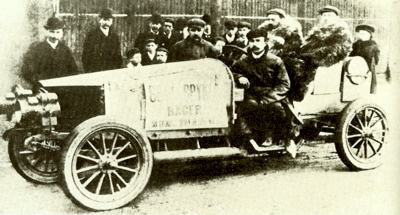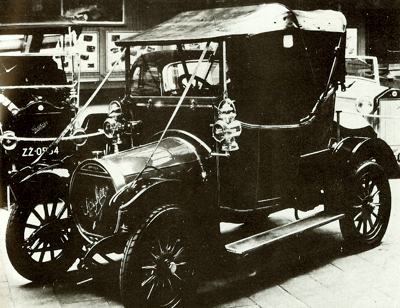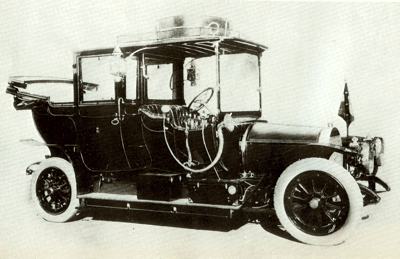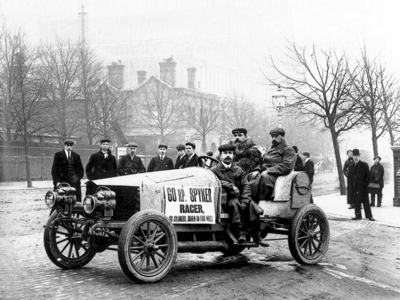Hendrik and Jacobus Spijker
For the most part, the pioneer Dutch car makers quietly built a handful of cars and then vanished equally quietly from the scene. But there was one exception ... Spyker, a marque which lasted for a quarter of a century, which built cars which were always technically advanced, and which achieved posthumous fame when one of its cars was selected as a star of the film Genevieve.
The brothers Hendrik and Jacobus Spijker were building carriages at Hilversum as early as 1880; then, in 1895, they began to import Benz cars from Germany and, latterly, to modify them, until in 1900 the first Spyker car saw the light of day. It was a voiturette with a front-mounted 5 hp air-cooled flat-twin engine; and the Spijker brothers (who had Anglicised the name of their product to facilitate export sales) had equipped a new factory at Trompenburg to cope with the anticipated demand.
Alas, it did not come, as the voiturette was a undistinguished little machine with none of the snob-appeal of an imported model; nor were there many overseas takers. Jacobus's next design was more promising. This was the 20 hp of 1902, which followed the lines of the contemporary Mercedes or Peugeot, with a 3770cc T-headed engine, with the cylinders cast separately, carried in a sub-frame between armoured wood side frames; there was also a 1885cc twin-cylinder version.
The four had the unusual feature for the period of a five-bearing crankshaft: but Spijker had plenty more technical surprises in store for the public. The first appeared at the end of 1903 in the shape of a 'circular engine' in which the cylinders were enclosed in a dustbin-like casting to ensure the maximum of cooling water around the combustion chambers: but water circulation was too sluggish, and the circular engine overheated furiously often during the course of the 1904 season.
Joseph Laviolette
More promising was what is generally accepted as being the world's first six-cylinder car, the design of a young Belgian named Joseph Laviolette. Spyker subsequently claimed that this car had been conceived as far back as 1901 and built in 1902, but not revealed until a comprehensive test programme had been completed. For, apart from its six cylinders, the big 8685cc Spyker also featured four-wheel-drive (though it wasn't the first four-wheel-drive vehicle, that distinction belonging to the Burstall & Hill steam coach of the 1820s, which also pioneered front wheel braking).
The six-cylinder Spyker also had rudimentary four-wheel-braking, as there were drum brakes on the rear wheels and a transmission brake which acted on the front wheels. The transmission was quite sophisticated: a cone clutch incorporated in the massive flywheel took the drive to a separate gearbox within which was a differential acting between the fore and aft drive shafts; these terminated in live axles also equipped with differentials, while the gearbox had two speed ranges, with three speeds in each, giving a total of six forward speeds and two reverse
It is likely that Laviolette and the Spijkers did not realise what they had wrought, as it seems as though they only regarded this complex transmission set-up as a panacea for the 'dreaded side-slip' – skidding - which was an ever-present danger on the greasy roads of the period. The car was revealed at the 1903 Paris Salon, and brought over to England a short while after for the Crystal Palace and Agricultural Hall exhibitions. Though this car was an experiment, and really intended for publicity purposes, Jacobus Spijker obviously 'considered with advantage' the merits of translating its complexities into production terms, as the six-cylinder, four-wheel-drive model was the basis of a limited run of 60 hp machines of similar design marketed during the 1904-7 period.
The Bexhill Speed Trials
Four-cylinder fwd touring cars were also built, and at least one came to Britain, competing in the Bexhill Speed Trials in either 1904 or 1905. The prototype six-cylinder car was retained by the company, and often driven on the road with a four-seated touring body with detachable canopy top. It also appeared in the odd competition: in 1906, Jacobus Spijker entered the car for the Birmingham Automobile Club's hillclimb, and, as they were crossing the North Sea on the Harwich ferry, Spijker's five-man team offered up communal prayers for rain on the day of the contest. The night before the event, the heavens opened, heavy rain poured down, and the test hill became slippery. The Spyker was the only competing vehicle to reach the summit, all the others being defeated by the greasy road surface.
 1903 Spyker 6-cylinder 8.5 liter racer.
1903 Spyker 6-cylinder 8.5 liter racer.
 1904 Spyker open-tourer.
1904 Spyker open-tourer.
 1906 Spyker twin-cylinder, Jacobus Spijkers forst two-cylinder model appeared in 1902 and followed the lines of the contemporary Mercedes and Peugeot models.
1906 Spyker twin-cylinder, Jacobus Spijkers forst two-cylinder model appeared in 1902 and followed the lines of the contemporary Mercedes and Peugeot models.
 1911 Spyker Landaulette. This particular picture is of Queen Wilhelmina's actual first Spyker car.
1911 Spyker Landaulette. This particular picture is of Queen Wilhelmina's actual first Spyker car.
 |
The Luton Dust Trials
The six-cylinder Spyker outlived the company: when the factory was sold up in 1925, the car was discovered, in an incomplete state, on an upper floor, and was acquired by an expatriate Dutchman resident in Paris called Springer. Springer had the car restored by an Amsterdam company, and it still survives in this modified form. Of course, more conventional vehicles were also offered: and it was the 1905 range which was to earn the marque its famous soubriquet 'Dustless'. Spykers were carefully streamlined underneath, and fitted with an undertray, which certainly minimised the raising of dust on the unmade roads of that era: and when Spyker achieved an outstanding result in the Luton Dust Trials of July 1905, their reputation was sealed as well. It was around this time that the marque acquired the famous round radiator that was to remain their hallmark until the end of production; and the 1906 range consisted of a 12/ 18 hp of 2799cc, a 15/24 hp of 3456cc, a 20/30 hp of 4562cc and a 30/40 hp of 7964cc.
C. N. and A. M. Williamson
It was almost certainly one of these models that the motor novelists C. N. and A. M. Williamson described as being typically Dutch: 'It made so little noise, yet moved so masterfully, and gave an impression of so much reserve power.' By 1907, there were 800 workmen at Trompenburg, and the order books seemed comfortably full. That year the range consisted of a diminutive 1810cc 10/15 hp, the 15/24hp, the 20/30hp and the 30/40 hp. An engaging scoundrel named Godard wheeled a Spyker out of the factory to enable him to compete in the 1907 Peking-Paris Race, falsely claiming that Le Ma-tin, the organiser of the event, would pay all expenses. M. Godard managed to scrounge his way across two continents until the exasperated Jacobus Spijker had him ejected from the car when it reached Berlin.
Drowned in the wreck of the SS Berlin
But this was just about the only light relief in a gloomy year for Spyker: in February 1907 Hendrik Spijker had been drowned in the wreck of the SS Berlin, and when the books were examined after his death it was revealed that the finances were in a parlous state. A slump had hit the car market that year, and the French agent had unexpectedly cancelled a big order for chassis, which could not be placed elsewhere, with the result that Spyker were considerably in debt. Though they survived the crisis, they never fully recovered from the blow. Models were little changed for 1908, except that the bore of the 15/24 was reduced, making the car a 15/20 and its swept volume 2799cc, the same as the 12/18 which had gone out of production a year earlier.
And there was – briefly - a sports-racing 40/80 hp at the head of the range, with a massive 10,603cc power unit. This was only produced during the 1908 season, but all the other models soldiered on until 1910, when they were replaced by cars of more radical concept. These had power units designed by Laviolette, with short transverse camshafts driven by worm direct from the crankshaft. There was one camshaft to each pair of cylinders, carrying two cams to actuate four valves; in 1911 Laviolette even delivered himself of a six-cylinder model built on these curious lines: it was not, apparently, a success, being subject to catastrophic internal derangements.
Queen Wilhelmina
Surprisingly, the transverse camshaft Spykers were noiseless as well as dustless: and Queen Wilhelmina bought two of the new 4589cc 25 hp models and a 7238cc 40 hp landaulette, which was very likely the Queen's first car. Smallest of the range was the 1791cc 12 hp, which had its gearbox incorporated in the back axle, but with a brake between clutch and transmission, which meant that it did not act when the car was in neutral, a factor which apparently contributed to a number of accidents. As Holland was neutral during World War 1, production continued, though at a level greatly reduced by shortages of raw materials.
The 'Flying Hens'
A handsome vee-fronted radiator, still circular, was adopted in 1914, but most of the wartime production of the firm was sold for military use. Spyker also made Clerget rotary aero-engines during the war; and adopted the image of a propeller superimposed on a wheel bearing the Latin motto Nulla Tenaci Invia est Via as their badge to signify their move into a new dimension. At the beginning of 1918 Spyker announced that they were abandoning car production until after the war; but by the end of the year they were back in the market with an all-new 13/30 model of 3.6 liters.
Its side-valve four-cylinder engine was built in unit with a three-speed transmission, and was obviously influenced by current American design trends: quite unique, however, was the 'aerocoque' coachwork fitted to a number of these chassis. With flared wings which appeared to be flapping ready for takeoff, a tiny tailfin, and bodywork styled like a fuselage, these cars were unkindly nicknamed the 'Flying Hens': their looks, it seems, were more impressive than their performance. Only 330 13/30S were built before another new Spyker model took over. This was the 30/40 hp, designed by Frederick Koolhoven, who was better known as an aircraft designer.
Guaranteed For Ever
It used a German Maybach engine of 5.7 liters, and the impression the car gave was one of ponderousness - even the open tourer scaled well over two tons. 'Guaranteed for ever,' was Spyker's proud boast about this car, and in July 1921 S. F. Edge chose a specially-bodied 30/40 to attempt to beat the 24 hour record which he had established in 1907 at Brooklands on a Napier. The engine was slightly modified, a straight-through exhaust was fitted, as were Hartford shock-absorbers, augmented at the rear by bungee straps between the axle and the frame. Driving for two periods of twelve hours, Edge averaged 74.27 mph, a great improvement over the 65.91 mph he had achieved fourteen years earlier, considering that he was now 51, and the Spyker's engine was far smaller than that of the Napier.
Mrs Gwenda Janson
At the same time that Edge was circulating round the track, the wife of the British Spyker concessionaire, Colonel Janson, was also indulging at some record-breaking at the track, with a Trump-JAP motorbike: Mrs Gwenda Janson (nee Glubb) would later achieve lasting fame as a lady racing driver under the name of Gwenda Hawkes. The big 30/40 was hardly a best-seller, and for a time Spyker toyed with the light car market, importing Mathis cars from Strasbourg and selling them as 'Spyker-Mathis,' but the venture was short lived. Probably around 150 of the 30/40 Spykers were made, and it was obvious that, despite continued patronage from Queen Wilhelmina, the company was no longer viable: in 1925 the Trompenburg factory closed its doors for ever, and the stock in hand was auctioned off.
